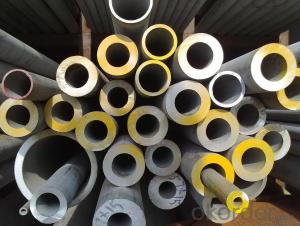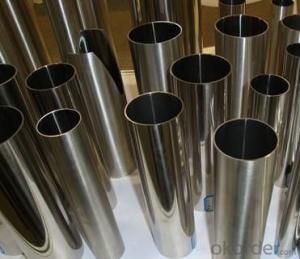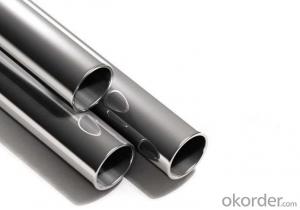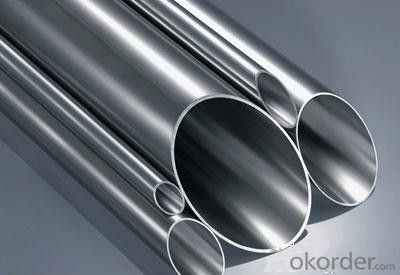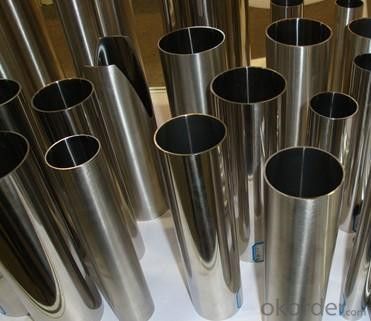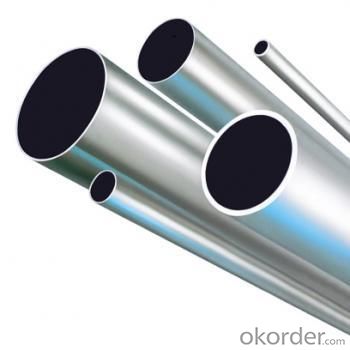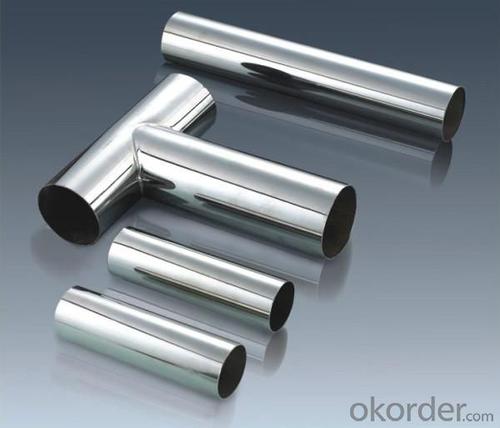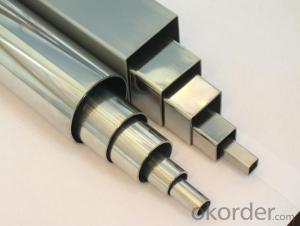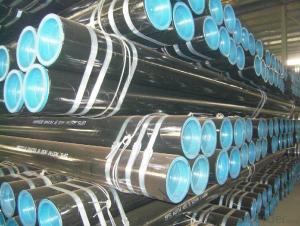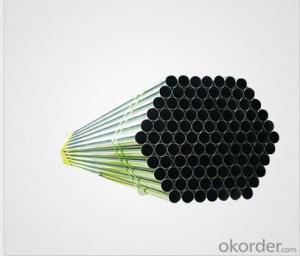A269 Seamless Stainless Steel Pipe
- Loading Port:
- China main port
- Payment Terms:
- TT OR LC
- Min Order Qty:
- 5 m.t.
- Supply Capability:
- 100000 m.t./month
OKorder Service Pledge
OKorder Financial Service
You Might Also Like
Specification
A269 Seamless Stainless Steel Pipe
1. Material | TP304/304L, 316/316L, 310S, 317L, 321, 347H,etc. |
S31803, 32750, etc. | |
2. Standard | ASTM, ASME, DIN, EN, ISO,JIS, GOST, etc. |
3. Type | Seamless |
4. Size range | OD: from 6mm to 1000mm (NPS from 1/8'' to 40'') |
WT: from 0.7mm to 38mm (Schedule from 5S to XXS) | |
Length: fix length or un-fix length, Max 30meters | |
5. Produce process | Pilgering and cold drawn |
6. Surface process | Pickling and annealing |
AP tube | |
BA tube | |
7. Marking | JW, GRADE, seamless, STANDARD, SIZE, HT NO. |
8. Package | Bundles with waterproof cloth outside. |
or plywood box. | |
9. Min order quantity | 500 KG |
10. Sample | Yes |
11. OEM accepted | Yes |
12. Production capacity | 300 tons per month |
13. Payment term | T/T or L/C. |
14. Certificate | ISO 9001, PED |
15. Third party ertificate | BV, LR, SGS, TUV, CCS, ABS, etc. |
Speciality and Advantages
Our company has been dedicated to producing stainless steel seamless pipe since 2003, owning complete producing technology and abundant managing experience.
The raw material such as mother tube, round bar we use is from Chinese biggest and well-known steel mill: Walsin Steel and Yongxing Steel.
We have advanced NDT equipments for the tests such as Eddy Current test, Ultrasonic test, Hydraulic test and so on.
We have ISO 9001 and PED certificate, and the Third Party Inspection Certificates such as TUV, BV, Lloyd’s, SGS, etc, also can be provided according to customers’ requirements,
Wooden case package which is strong and suitable for sea transportation is our main method to pack the pipes. And the economical packing method such as packed in bundles is also welcomed by some customers.
The tolerance control we use is D4/T4 (+/-0.1mm) on both inside and outside Diameter and Wall Thickness, which is much higher than international standard ASTM, DIN.
The surface condition is one of our main advantages: in order to meet different requirements for surface condition, we have annealing and pickling surface, bright annealing surface, OD polished surface, OD & ID polished surface etc.
In order to keep the inside surface of pipe clean and make it free from deburring, our company develops the unique and special technology --- Sponge Washing with high pressure.
We have complete after-sale service to deal with the problems in time.

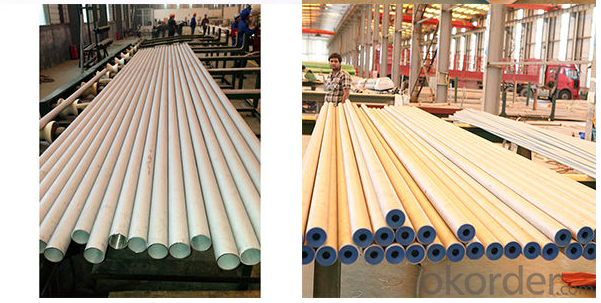
- Q: Are stainless steel pipes resistant to scaling and pitting?
- Yes, stainless steel pipes are highly resistant to scaling and pitting due to their inherent corrosion-resistant properties.
- Q: What is the difference between inside diameter and outside diameter in stainless steel pipes?
- The inside diameter refers to the measurement of the inner space or bore of a stainless steel pipe, while the outside diameter refers to the measurement of the outer circumference or width of the pipe. Essentially, the inside diameter determines the flow capacity of the pipe, while the outside diameter determines the overall size and strength of the pipe.
- Q: What is the welding procedure for stainless steel pipes?
- To achieve a strong and durable joint, stainless steel pipes undergo a specific welding procedure. Typically, the process entails several crucial steps. To begin, it is essential to choose the appropriate welding technique for stainless steel, which is often Tungsten Inert Gas (TIG) welding due to its ability to produce precise and clean welds. Before commencing the welding process, it is necessary to thoroughly clean the stainless steel pipes to eliminate any contaminants like dirt, grease, or oxidation. This can be accomplished using either a degreasing agent or a stainless steel wire brush. Following the cleaning process, the pipes must be aligned and fitted together correctly. It is crucial to ensure that the gap between the pipes remains consistent and even throughout the joint. This can be achieved by temporarily securing the pipes in place using clamps or tack welding. Once the pipes are properly aligned, the TIG welding process can commence. This involves using a TIG torch to create an electric arc between a tungsten electrode and the stainless steel pipes. The intense heat generated by the arc melts the edges of the pipes, creating a fusion between the base metal and the filler material. During the welding process, it is vital to maintain a stable arc length and control the welding speed to achieve a uniform weld bead. Regulating the heat input and controlling the welding parameters can be accomplished by utilizing a foot pedal or a remote control. Throughout the welding process, it is important to safeguard the weld area from contamination. This can be achieved by using shielding gas, such as argon, to establish an inert atmosphere around the weld zone. The shielding gas prevents the weld area from reacting with oxygen and other atmospheric elements that could result in weld defects. Upon completing the welding, it is advisable to perform post-weld cleaning and inspection. This involves removing any slag or spatter that may have formed during the welding process and visually examining the weld for any defects like cracks or discontinuities. In summary, the welding procedure for stainless steel pipes involves cleaning the pipes, aligning and fitting them together, TIG welding with the appropriate arc length and welding speed, shielding the weld area with inert gas, and conducting post-weld cleaning and inspection. By following these steps, a dependable and sturdy weld joint can be achieved for stainless steel pipes.
- Q: What are the different types of stainless steel pipe caps?
- There are various types of stainless steel pipe caps, including threaded caps, socket weld caps, butt weld caps, and compression caps.
- Q: What is the difference between seamless and seamless annealed stainless steel pipes?
- The manufacturing process and resulting properties of seamless and seamless annealed stainless steel pipes are the main points of differentiation between them. Seamless stainless steel pipes are created by piercing a hot billet or solid bar, forming a seamless hollow cylindrical shape. This manufacturing method eliminates the need for welding or any other joints, resulting in a continuous and uniform pipe without any seams. Seamless pipes are highly regarded for their exceptional strength and ability to withstand high pressures, making them a suitable choice for various industries such as oil and gas, petrochemical, and construction. On the contrary, seamless annealed stainless steel pipes undergo an additional heat treatment process known as annealing. Annealing involves heating the pipe to a specific temperature, maintaining it at that temperature for a certain duration, and then gradually cooling it. This heat treatment helps relieve internal stresses, decrease hardness, enhance ductility, and improve the overall mechanical properties of the stainless steel pipe. Moreover, the annealing process fosters the development of a more homogeneous microstructure, further improving the corrosion resistance of the stainless steel. This characteristic makes seamless annealed stainless steel pipes particularly appropriate for industries that require excellent resistance to corrosion, such as chemical processing, pharmaceuticals, and the food and beverage sectors. To sum up, although both seamless and seamless annealed stainless steel pipes are produced without any seams, the latter's additional annealing process enhances its mechanical properties and corrosion resistance, making it more suitable for specific industries and applications.
- Q: Are stainless steel pipes resistant to pitting and crevice corrosion?
- Stainless steel pipes exhibit high resistance to pitting and crevice corrosion as a result of the chromium oxide protective layer on their surface. This layer acts as a barrier, effectively warding off corrosive elements. Furthermore, it possesses the remarkable ability to self-heal, swiftly regenerating in the event of any damage, thus ensuring continued resistance against corrosion. Given these qualities, stainless steel pipes find widespread usage in various industries, such as chemical, oil and gas, and food processing, where they are constantly exposed to aggressive surroundings. All in all, stainless steel pipes are a dependable option when corrosion resistance is of utmost importance.
- Q: What is the difference between 410 and 316 stainless steel pipes?
- The main difference between 410 and 316 stainless steel pipes lies in their chemical composition and their intended applications. 410 stainless steel is a martensitic stainless steel, which means it has a high carbon content (between 0.15% and 0.25%) and a relatively low chromium content (between 11.5% and 13.5%). This composition gives 410 stainless steel pipes excellent strength, hardness, and wear resistance. It is often used in applications where corrosion resistance is not the primary concern, such as in cutting tools, knives, and firearm components. On the other hand, 316 stainless steel is an austenitic stainless steel with a higher chromium content (between 16% and 18%) and a significant amount of nickel (between 10% and 14%). This composition gives 316 stainless steel pipes excellent corrosion resistance, especially in environments with chlorides or other corrosive agents. It is widely used in industries such as chemical processing, pharmaceuticals, food processing, and marine applications. In summary, the main difference between 410 and 316 stainless steel pipes is their chemical composition and the resulting properties. 410 stainless steel offers superior strength and hardness but has lower corrosion resistance compared to 316 stainless steel, which is highly corrosion resistant but may have slightly lower strength and hardness. The choice between the two depends on the specific requirements of the application, with 410 stainless steel being more suitable for applications where strength and wear resistance are crucial, and 316 stainless steel being preferred for applications requiring excellent corrosion resistance.
- Q: What are the advantages of using stainless steel pipes in the automotive industry?
- There are several advantages of using stainless steel pipes in the automotive industry. Firstly, stainless steel pipes offer excellent corrosion resistance, which is crucial in automotive applications where the pipes are exposed to various environmental conditions. Secondly, they have high strength and durability, making them reliable for withstanding high pressure and temperature conditions. Additionally, stainless steel pipes have good thermal conductivity, allowing for efficient heat transfer and preventing overheating in the vehicle's engine or exhaust system. Lastly, they are lightweight compared to other materials, contributing to improved fuel efficiency and overall vehicle performance.
- Q: Can stainless steel pipes handle high temperatures?
- Yes, stainless steel pipes are capable of handling high temperatures.
- Q: Can stainless steel pipes be insulated with mineral wool?
- Yes, stainless steel pipes can be insulated with mineral wool. Mineral wool is a common insulating material that can be used on various types of pipes, including stainless steel. It provides thermal insulation and helps to prevent heat loss or gain, depending on the application.
Send your message to us
A269 Seamless Stainless Steel Pipe
- Loading Port:
- China main port
- Payment Terms:
- TT OR LC
- Min Order Qty:
- 5 m.t.
- Supply Capability:
- 100000 m.t./month
OKorder Service Pledge
OKorder Financial Service
Similar products
Hot products
Hot Searches
Related keywords

